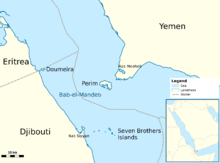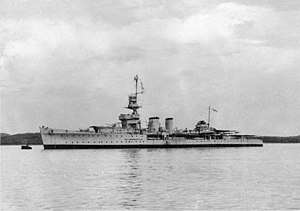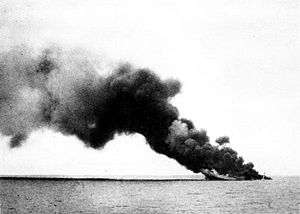Red Sea Flotilla
The Red Sea Flotilla (Flottiglia del mar rosso) was part of the Regia Marina Italia (Italian Royal Navy) based at Massawa in the colony of Italian Eritrea, part of Italian East Africa. In World War II, the Red Sea Flotilla was active against the East Indies Station of the Royal Navy, from the Italian declaration of war on 10 June 1940 until the fall of Massawa on 8 April 1941.
| Red Sea Flotilla | |
|---|---|
Red Sea and Gulf of Aden, with modern boundaries | |
| Active | to June 1940 |
| Disbanded | April 1941 |
| Country | Italy |
| Branch | Regia Marina |
| Size | 7 destroyers, 8 submarines, 5 motor torpedo boats, and 9 auxiliary ships |
| Commanders | |
| Commander | Carlo Balsamo di Specchia Normandia (1939 – December 1940) Mario Bonetti (December 1940 – April 1941) |
The squadron was isolated from the main Italian bases in the Mediterranean by distance and British dispositions. The British capture of Massawa and other Italian ports in the region ended the Italian naval presence in the region in April 1941.
Purpose and organisation
On 10 June 1940, the Red Sea Flotilla had seven destroyers in two squadrons, a squadron of five Motor Torpedo Boats (MAS, Motoscafo Armato Silurante) and eight submarines in two squadrons. The main base was at Massawa, with other bases at Assab (also in Eritrea) and Kismayu, in southern Italian Somaliland.[1] The Red Sea Flotilla was not used aggressively by the Italians but the British viewed it as a potential threat to Allied convoys travelling East African waters between the Mediterranean Sea and the Indian Ocean. This was a vital route for British forces operating from Egypt. The Red Sea Flotilla was especially well situated to attack convoys headed from the Gulf of Aden through the Red Sea to the Suez Canal, after the Mediterranean was closed to Allied merchant ships, which had to take passage around the Cape of Good Hope.
Actions

Several attempts were made to stage offensive actions against the British Royal Navy and Allied convoys from Massawa. Some of the earliest failed when submarine air conditioning systems, intended to reduce temperatures in the warm water of the Red Sea proved dangerous under wartime operating conditions. Leakage of chloromethane refrigerants caused central nervous system poisoning in the recirculating air during submerged operations and about twelve sailors died aboard Archimede. The submarines Perla and Macallé ran aground while their crews were intoxicated by chloromethane and the latter could not be salvaged.[2] The submarines Galileo Galilei, Torricelli and Galvani struck early; Galileo Galilei sank the Norwegian freighter James Stove off Djibouti, before British counter-measures forced the submarines to depart the area.
Torricelli was spotted on 23 June, while approaching Massawa and an intensive search was conducted by four warships aided by aircraft from Aden. After fierce resistance, during which the sloop HMS Shoreham was damaged by return fire, Torricelli was sunk. After the engagement, the destroyer HMS Khartoum was destroyed by an internal explosion. As a mark of respect for the gallantry of the Torricelli crew, the Italian captain was guest of honour at a dinner at the British naval base. Galileo Galilei had also been found on 18 June, captured and taken to Aden on the same day. Galvani sank HMIS Pathan at the same time that her sisters were fighting and was sunk on the following day.[3][lower-alpha 1]
In October 1940, the destroyers based at Massawa conducted an attack on the 32-ship Convoy BN 7. The escorts beat off the attack and Nullo was driven ashore and sunk by air attack the following day.[3] On the British side, only the leading transport ship of the convoy sustained minor splinter damage and HMS Kimberley was crippled by Italian shore batteries, with three wounded among her crew and had to be towed to Aden by the cruiser HMNZS Leander.[5]

As Italian fuel stocks at Massawa dwindled, the offensive capability of the Red Sea Flotilla declined. The vessels of the flotilla became a "fleet in being", offering a threat without action and rarely left port. In late March 1941, the three large destroyers, Leone, Pantera and Tigre, made a night attack on Suez but Leone ran aground off Massawa and had to be scuttled by gunfire and the delay caused the operation to be cancelled. The two remaining ships joined three smaller destroyers – Battisti, Manin and Sauro on a final raid on Port Sudan in early April. Engine problems kept Battisti in port, where she was subsequently scuttled to prevent her capture by the British. The Italian ships were spotted by aircraft while en route and came under attack from land and carrier based aircraft. Pantera and Tigre were scuttled on the Arabian coast while Manin and Sauro were sunk by Fairey Swordfish aircraft.[3][6] On 8 April 1941, the light cruiser HMS Capetown was torpedoed and crippled by the Italian torpedo boat MAS 213 off Massawa. The cruiser was out of action until June 1942.[7]

The armed merchant cruisers Ramb I, Ramb II and the colonial dispatch ship Eritrea were ordered to escape and reach Japan. Ramb II and Eritrea reached Kobe but Ramb I was intercepted and sunk by Leander. The four Italian submarines that had survived were ordered to join BETASOM the Italian submarine flotilla at Bordeaux and succeeded, despite concerted British attempts to intercept them.[3] On 8 April 1941, Massawa fell to the British and the Red Sea Flotilla ceased to exist. Few vessels of the flotilla survived the East African Campaign.
Order of battle
Destroyers
Seven destroyers were organised into two divisions:
- 3rd Destroyer Division (All Sauro class[8] (1,600 ton full load displacement))
- Francesco Nullo – Crippled by HMS Kimberley and eventually destroyed by RAF 22 November 1940
- Nazario Sauro – Bombed and sunk by 813 and 824 Naval Air Squadrons at 06:15 3 April 1941 in position 20.00°N 30.00°E[9]
- Cesare Battisti – scuttled after engine breakdown 3 April 1941.[9]
- Daniele Manin (1,058/1,600 tons displacement) – Sunk by RAF 3 April 1941 in position 20.33°N 30.17°E[9]
- 5th Destroyer Division (All Leone class (2,600 ton full load displacement)) [8]
- Pantera – Scuttled 3 April 1941 after being damaged by RAF[9]
- Tigre – Scuttled 3 April 1941 after being damaged by RAF[9]
- Leone – Ran aground and scuttled 1 April 1941 in position 16.15°N 39.92°E[9]
MAS (Motor torpedo boats)
The five MAS were organised as follows:
- 21st MAS Squadron
- MAS 204 – Lost due to mechanical failure
- MAS 206 – Lost due to mechanical failure
- MAS 210 – Lost due to mechanical failure
- MAS 213 – Scuttled 8 April 1941
- MAS 216 – Lost due to mechanical failure
VIII Submarine Group
- 81st Submarine Squadron
- Guglielmotti (896/1,265 tons displacement) – Sailed to Bordeaux, France and arrived 6 May 1941[10]
- Galileo Ferraris (880/1,230 tons displacement) – Sailed to Bordeaux, France and arrived 9 May 1941[10]
- Galileo Galilei (880/1,230 tons displacement) – Captured 19 June 1940
- Luigi Galvani (896/1,265 tons displacement) – Sunk 24 June 1940
- 82nd Submarine Squadron
- Perla (620/855 tons displacement) – Sailed for Bordeaux, France, arrived 20 May 1941[10]
- Macallé (620/855 tons displacement) – Ran aground and scuttled 15 June 1940
- Archimede (880/1,230 tons displacement) – Sailed for Bordeaux, France, arrived 7 May 1941[10]
- Evangelista Torricelli (880/1,230 tons displacement) – Sunk 23 June 1940
Other vessels
- Colonial ship Eritrea (2,170 tons displacement) – Sailed to Kobe, Japan, and turned to the Allies in Columbo, Ceylon, when Italy capitulated in September 1943
- Torpedo boat Vincenzo Giordano Orsini (670 tons displacement) – Scuttled 8 April 1941
- Torpedo boat Giovanni Acerbi (670 tons displacement) – Scuttled in the mouth of the harbour at Massawa as a blockship after suffering heavy bomb damage[9]
- Gunboat G. Biglieri (620 tons displacement) – Captured
- Gunboat Porto Corsini (290 tons displacement) – Scuttled
- Minelayer Ostia (620 tons displacement) – Sunk by British Royal Air Force attack within the harbour at Massawa; all mines still racked
- Auxiliary cruiser Ramb I (3,667 tons displacement) – Sailed to Kobe, Japan. Lost 27 February 1941 in battle against the light cruiser HMNZS Leander.
- Auxiliary cruiser Ramb II (3,667 tons displacement) – Sailed to Kobe, Japan, and placed into the service of the Imperial Japanese Navy when Italy surrendered
- Hospital ship Aquileia – former Ramb IV – Captured and placed into the service of the British Royal Navy
See also
- Italian Royal Navy
- List of Italian destroyers
Notes
- Kindell disputes that Pathan was sunk by Torricelli.[4]
Footnotes
- RMI 2007.
- "The Military Operations of the Italian Flee on Red Sea June 1940 – April 1941". Arnaldo Borsa. Retrieved 2012-08-02.
- Jackson 2006, pp. 281–283.
- Kindell 2012.
- O'Hara 2009, p. 103.
- Whitley 2000, pp. 158–161.
- "HMS Capetown, British light cruiser, WW2". Naval History net. Retrieved 2016-01-30.
- Porch 2004, p. 129.
- Brown Warship Losses of World War Two p.43
- Blair Hitler's U-Boat War p.739
References
Books
- Blair, Clay (1996). Hitler's U-Boat War: The Hunters 1939–1942. New York: Random House. ISBN 978-0-394-58839-1.
- Brown, David (1995). Warship Losses of World War Two. New York: Naval Institute Press. ISBN 978-1-55750-914-7.
- Ellsberg, Commander Edward (1946). Under the Red Sea Sun. Dodd, Mead. OCLC 869413049.
- Jackson, Ashley (2006). The British Empire and the Second World War. London: Hambledon Continuum. ISBN 978-1-85285-417-1.
- O'Hara, Vincent P. (2009). Struggle for the Middle Sea: The Great Navies at War in the Mediterranean Theater, 1940–1945. Annapolis, Maryland: Naval Institute Press. ISBN 978-1-59114-648-3.
- Porch, Douglas (2004). The Path to Victory: The Mediterranean Theater in World War II. New York: Farrar, Strauss & Giroux. ISBN 978-0-374-20518-8.
- Whitley, M. J. (2000). Destroyers of World War Two: An International Encyclopedia. London: Arms and Armour Press. pp. 158–161. ISBN 978-1-85409-521-3.
Websites
- D'Adamo, Cristiano. "Royal Italian Navy in the Red Sea". Archived from the original on 2007-08-16. Retrieved 2007-09-04.
- "Italian Naval Bases; Order of Battle, Italian East Africa Naval Command". Regia Marina Italiana. 1996–2007. Archived from the original on 2008-12-18. Retrieved 2 Jan 2009.
- Heddlesten, James. "Comando Supremo: Italy at War. Events of 1941". Retrieved 20 December 2007.
- Kindell, Don (2012). "Sunday, 23 June". British and Other Navies in World War 2 Day-by-Day. Retrieved 29 Dec 2008.
Further reading
- Roskill, S. W. (1957) [1954]. Butler, J. R. M. (ed.). The Defensive. History of the Second World War United Kingdom Military Series: The War at Sea 1939–1945. I (4th impr. ed.). London: HMSO. OCLC 881709135. Retrieved 14 November 2017.
- Roskill, S. W. (1962) [1956]. The Period of Balance. History of the Second World War: The War at Sea 1939–1945. II (3rd impression ed.). London: HMSO. OCLC 174453986. Retrieved 14 November 2017.